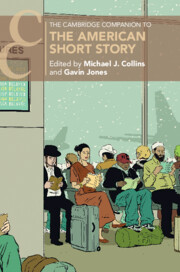Book contents
- The Cambridge Companion to the American Short Story
- The Cambridge Companion to the American Short Story
- Copyright page
- Contents
- Figures
- Tables
- Contributors
- Chronology
- Introduction
- Part I Contexts
- Chapter 1 Transatlantic Print Culture and the Emergence of Short Narratives
- Chapter 2 The Short Story and the Early Magazine
- Chapter 3 The Short Story Fad
- Chapter 4 The Best of the Best
- Chapter 5 The Story of a Semester
- Chapter 6 The Short Story in the Age of the Internet
- Part II Histories
- Part III People and Places
- Part IV Theories
- Notes
- Further Reading
- Index
- Cambridge Companions to…
- References
Chapter 3 - The Short Story Fad
Gender, Pleasure, and Commodity Culture in Late Nineteenth-Century Magazines
from Part I - Contexts
Published online by Cambridge University Press: 11 May 2023
- The Cambridge Companion to the American Short Story
- The Cambridge Companion to the American Short Story
- Copyright page
- Contents
- Figures
- Tables
- Contributors
- Chronology
- Introduction
- Part I Contexts
- Chapter 1 Transatlantic Print Culture and the Emergence of Short Narratives
- Chapter 2 The Short Story and the Early Magazine
- Chapter 3 The Short Story Fad
- Chapter 4 The Best of the Best
- Chapter 5 The Story of a Semester
- Chapter 6 The Short Story in the Age of the Internet
- Part II Histories
- Part III People and Places
- Part IV Theories
- Notes
- Further Reading
- Index
- Cambridge Companions to…
- References
Summary
This chapter considers the popularity of the genre of the short story in the late nineteenth and early twentieth centuries. It explores, in particular, a class of magazine stories for which the terms of approval followed the lines of reading for amusement and entertainment. Surveying critical accounts of the short story, and the burgeoning interest in anthologies and handbooks for aspiring writers, the chapter considers what follows if we not only accept but accentuate the notion of the genre as an artistic commodity in a gendered marketplace defined by overabundance. Special consideration is given to the subgenre of “storiettes” published alongside a column covering “the latest fads” in Munsey’s magazine. The essay argues that the style of the period’s short story developed in tandem with ideas about it as a fashionable and consumable commodity, and even as something of a fad.
Keywords
- Type
- Chapter
- Information
- The Cambridge Companion to the American Short Story , pp. 46 - 61Publisher: Cambridge University PressPrint publication year: 2023

